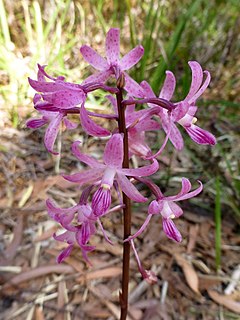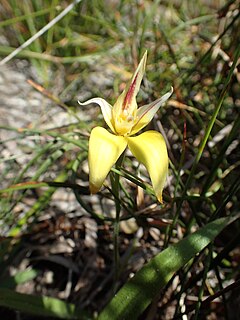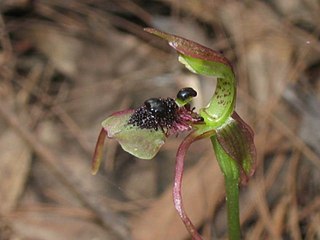
Dipodium, commonly known as hyacinth orchids, is a genus of about forty species of orchids native to tropical, subtropical and temperate regions of south-east Asia, New Guinea, the Pacific Islands and Australia. It includes both terrestrial and climbing species, some with leaves and some leafless, but all with large, often colourful flowers on tall flowering stems. It is the only genus of its alliance, Dipodium.

Dipodium punctatum, commonly known as the blotched hyacinth-orchid, is a leafless orchid that is a native to eastern and south-eastern continental Australia. In summer it produces a tall flowering stem with up to sixty pale to bright pink flowers with heavy red blotches. A widespread and common species it is often confused with D. roseum and some authorities regard it as a synonym of D. squamatum.

Dipodium roseum, commonly known as rosy hyacinth-orchid or pink hyacinth-orchid, is a leafless saprophytic orchid found in east and south-eastern Australia. In summer it produces a tall flowering stem with up to fifty pale pink flowers with small, dark red spots. A widespread and common species it is often confused with D. punctatum but has darker, less heavily spotted flowers.

Dipodium variegatum, commonly known as the slender hyacinth-orchid, or blotched hyacinth-orchid, is a leafless mycoheterotrophic orchid that is endemic to south-eastern Australia. It forms mycorrhizal relationships with fungi of the genus Russula.
Dipodium campanulatum, commonly known as the bell-flower hyacinth orchid, is a leafless mycoheterotroph orchid that is endemic to south-eastern Australia. In summer it has up to thirty five white flowers with large, dark red spots and blotches.

Dipodium stenocheilum, commonly known as tropical hyacinth-orchid, is a leafless saprophytic orchid that is endemic to northern Australia. For most of the year the plant is dormant but in summer it produces a tall flowering stem with up to twenty five white flowers with purple spots and a mauve labellum.

Dipodium ensifolium, commonly known as leafy hyacinth-orchid, is an orchid species that is endemic to north-east Queensland. It has sword-shaped leaves and up to twenty pink to mauve flowers with purplish spots and blotches.

Dipodium atropurpureum, commonly known as the purple hyacinth orchid, is an almost leafless mycoheterotrophic orchid that is endemic to New South Wales. In summer it has up to forty dark pinkish purple to reddish purple flowers with darker spots and blotches on a tall flowering stem.
Dipodium pulchellum is an almost leafless orchid that is endemic to north-east New South Wales and south-east Queensland in Australia. Up to forty pink flowers with darker blotches are borne in summer and winter on flowering spikes up to 90 cm (40 in) long.

Caladenia flava subsp. sylvestris, commonly known as the karri cowslip orchid, is a species of orchid endemic to the south-west of Western Australia. It has a single, hairy leaf and up to three pale yellow and cream-coloured flowers which are white near the tips of the sepals and petals and marked with bright red or pink.
Caladenia insularis, commonly known as French island spider orchid is a plant in the orchid family Orchidaceae and is endemic to Victoria. It is a ground orchid with a single leaf and usually only one cream-coloured, pink or pale yellow flower, heavily streaked with red. It is only known from French Island.
Caladenia saxatilis is a plant in the orchid family Orchidaceae and is endemic to South Australia. It is a ground orchid with a single hairy leaf and one or two pale creamy-green flowers, sometimes with thin reddish lines. It occurs in the southern Flinders Ranges.
Caladenia strigosa is a plant in the orchid family Orchidaceae and is endemic to South Australia. It is a ground orchid with a single leaf and a single greenish-cream flower with fine reddish streaks. It grows in sandy soil in shrubland.
Genoplesium confertum, commonly known as the crowded midge orchid, is a small terrestrial orchid endemic to the south-east of Queensland. It has a single thin leaf fused to the flowering stem and up to sixty small, densely crowded, reddish and green flowers and grows in coastal heath.
Chiloglottis longiclavata, commonly known as the northern wasp orchid, is a species of orchid endemic to Queensland. It has two leaves and a single narrow, pinkish green flower with a dark blackish red callus covering most of the upper surface of the labellum.

Chiloglottis seminuda, commonly known as the turtle orchid, is a species of orchid endemic to south-eastern New South Wales. It has two broad leaves and a single green or reddish pink flower with a shiny black insect-like callus covering two-thirds of the base of the labellum but with the tip of the labellum free of callus.
Chiloglottis sphaerula is a species of orchid endemic to a small part of New South Wales. It has two dark green leaves and a single green to reddish pink flower with a shiny black insect-like callus covering two-thirds of the base of the labellum but with the tip of the labellum free of callus.

Chiloglottis triceratops, commonly known as the three-horned bird orchid, is a species of orchid endemic to Tasmania. It has two broad leaves and a greenish brown to purplish brown flower with a few column-like calli near the mid-line of the labellum.
Thelymitra media, commonly called the tall sun orchid, is a species of orchid that is endemic to eastern Australia. It has a single fleshy, channelled leaf and up to thirty blue flowers with darker streaks but without spots. The labellum is narrower than the other petals and sepals.
Gastrodia urceolata, commonly known as white potato orchid, is a leafless terrestrial mycotrophic orchid in the family Orchidaceae. It has a pale brown, fleshy flowering stem and up to fifty five upright, white to pale brown flowers. It is only known from a single population near Atherton in Queensland.










